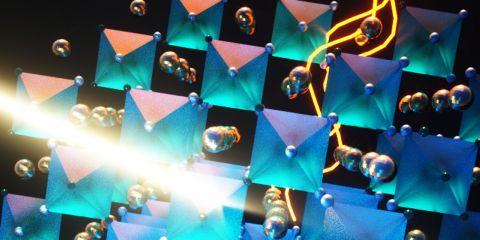Lead-free Perovskites
In recent years, semiconductor research has witnessed the irresistible rise of lead-halide perovskites, whose well-conditioned optoelectronic properties have enabled impressive performance in photovoltaics, photodetectors, light-emitting devices, etc. However, the toxicity associated with their lead content poses a considerable challenge to their commercialization. Therefore, investigators have set out to develop and explore alternative lead-free perovskite-inspired materials (PIMs), which are structurally and electronically similar to lead-halide perovskites, but without the same toxicity burden. In addition to providing a green route to perovskite optoelectronics, most PIMs can also be processed at low temperatures and through solution-based methods (e.g., printing and coating), which opens up attractive opportunities for sustainable large-area optoelectronics.
At the Pecunia Research Group, we seek to develop and gain insight into new lead-free PIMs, as well as to assess their potential for optoelectronic and energy applications (e.g., photovoltaics, photodetectors, thin-film transistors). This endeavor firstly involves the synthesis of new lead-free PIMs, their compositional manipulation, and their crystallographic and microstructural enhancement. This materials-driven effort goes hand in hand with our optoelectronics characterization of these materials. In turn, the resulting insight informs our further material development/manipulation efforts as well as our integration of these materials in suitable optoelectronic devices. The overarching aim of this multidisciplinary research effort is to realize the full potential of lead-free PIMs for sustainable optoelectronics and photovoltaics.
Our research in lead-free PIMs has thus far primarily focused on antimony- and bismuth-based PIMs—for instance, defect-ordered perovskite derivatives with a formula A3B2X9 and silver-bismuth-iodide rudorffites. The attractiveness of these PIMs lies not only in the substantially lower toxicity of bismuth and antimony compared to lead, but also in their electronic similarity with high-performance lead-halide perovskites. At a materials level, we have developed processing protocols and synthetic approaches that allow the deposition of thin films of such materials with attractive microstructural and crystallographic properties. We have additionally gained insight into their optoelectronic properties by studying their ability to convert light into electricity, as well as their charge transport and defect-state properties. Finally, we have demonstrated their capabilities in photovoltaics and photodetectors—for instance, achieving record-high external quantum efficiencies (~65%) for materials of these classes, and providing the first-ever demonstration of visible-light photodetectors based on silver-bismuth-iodide rudorffites.

a) Our newly-developed processing protocols enable a dramatic enhancement of the microstructure of layered Rb3Sb2I9, leading to cutting-edge photoconversion efficiencies (10.1039/C9TA13352F).
b) Our newly-developed low-temperature route to the conversion of 0D Cs3Sb2I9 into 2D Cs3Sb2ClxI9-x results in enhanced charge transport properties and photoconversion efficiency (10.1016/j.apmt.2020.100637).
Representative Publications
V. Pecunia†*, J. Zhao, C. Kim, B. R. Tuttle, J. Mei, F. Li, Y. Peng, T. Huq, R. L.Z. Hoye, N. D. Kelly, S. E. Dutton, K. Xia, J. MacManus-Driscoll, H. Sirringhaus, Assessing the Impact of Defects on Lead-Free Perovskite-Inspired Photovoltaics via Photo-Induced Current Transient Spectroscopy, Advanced Energy Materials, 2021. DOI: 10.1002/aenm.202003968
Y. Peng*, T. N. Huq*, J. Mei*, L. Portilla, R. A. Jagt, L. G. Occhipinti, J. L. MacManus-Driscoll, R. L. Z. Hoye†, V. Pecunia†, Lead-Free Perovskite-Inspired Absorbers for Indoor Photovoltaics, Advanced Energy Materials, 11, 1, 2002761, 2021. DOI: 10.1002/aenm.202002761
V. Pecunia†, L. G. Occhipinti†, A. Chakraborty, Y. Pan, Y. Peng, Lead-Free Halide Perovskite Photovoltaics: Challenges, Open Questions and Opportunities, APL Materials, 8(10), 100901, 2020. DOI: 10.1063/5.0022271
Y. Peng*, F. Li, Y. Wang, Y. Li, R. L.Z. Hoye, L. Feng, K. Xia, V. Pecunia†*, Enhanced photoconversion efficiency in cesium-antimony-halide perovskite derivatives by tuning crystallographic dimensionality, Applied Materials Today, 19, 100637, 2020. DOI: DOI: 10.1016/j.apmt.2020.100637
T. N. Huq*, L. C. Lee*, L. Eyre, W. Li, R. A. Jagt, C. Kim, S. Fearn, V. Pecunia, F. Deschler, J. L. MacManus-Driscoll, R. L. Z. Hoye†, Electronic Structure and Optoelectronic Properties of Bismuth Oxyiodide Robust against Percent-Level Iodine-, Oxygen-, and Bismuth-Related Surface Defects, Advanced Functional Materials, 30, 1909983, 2020. DOI: 10.1002/adfm.201909983
F. Li*, Y. Wang, K. Xia, R. L. Z. Hoye, V. Pecunia†*, Microstructural and Photoconversion Efficiency Enhancement of Compact Films of Lead-Free Perovskite Derivative Rb3Sb2I9, Journal of Materials Chemistry A, 8, 4396–4406, 2020. DOI: 10.1039/C9TA13352F
V. Pecunia†*, Y. Yuan*, J. Zhao, K. Xia, Y. Wang, S. Duhm, L. Portilla, F. Li, Perovskite-Inspired Lead-Free Ag2BiI5 for Self-Powered NIR-Blind Visible Light Photodetection, Nano-Micro Letters, 12:27, 2020. DOI: 10.1007/s40820-020-0371-0
V. Pecunia†, Efficiency and Spectral Performance of Narrowband Organic and Perovskite Photodetectors: a Cross-Sectional Review, Journal of Physics: Materials, 2, 042001, 2019. DOI: 10.1088/2515-7639/ab336a






